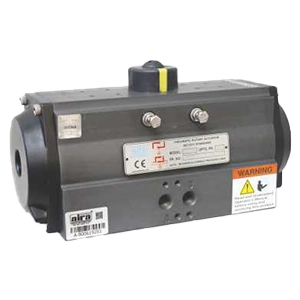Understanding Pneumatic Rotary Actuators: Types, Working, and ApplicationsPosted by Aira Euro on February 23rd, 2023  Introduction to Pneumatic Rotary ActuatorsPneumatic rotary actuators are devices that convert the energy from compressed air into mechanical motion, which is used to rotate an object. These actuators are widely used in various industrial applications, such as assembly lines, packaging machines, and conveyor systems. They are also used in robotics, automated equipment, and other industrial processes that require precision and reliability. Types of Pneumatic Rotary ActuatorsThere are two main types of pneumatic rotary actuators: rack and pinion and vane actuators. Rack and pinion actuators: Rack and pinion actuators are the most common type of pneumatic rotary actuators. They consist of a gear rack attached to the piston rod, which engages with a pinion gear. When air pressure is applied, the piston moves, causing the gear rack to rotate the pinion gear and the output shaft. Vane actuators: Vane actuators use a rotor with vanes that slide in and out of slots in the housing. When air pressure is applied, the vanes are forced out of the slots, causing the rotor to rotate. Vane actuators are typically used in applications where high torque is required. Working of Pneumatic Rotary ActuatorsPneumatic rotary actuator work by converting the energy from compressed air into mechanical motion. When air pressure is applied to the actuator, the piston or rotor moves, causing the output shaft to rotate. The direction of rotation depends on the design of the actuator and the direction of the airflow. To control the speed and direction of rotation, the actuator is equipped with control valves that regulate the airflow. These valves can be manual or automated, depending on the application. The control valves can be used to adjust the speed, torque, and direction of rotation of the actuator. Applications of Pneumatic Rotary ActuatorsPneumatic rotary actuators are used in a wide range of applications, including: Manufacturing: Pneumatic rotary actuators are used in manufacturing processes such as assembly lines, packaging machines, and conveyor systems. They are used to move and position parts and products and to control the speed and direction of motion. Robotics: Pneumatic rotary actuators are used in robotics to provide motion and control. They are used to move robot arms, grippers, and other components. Material Handling: Pneumatic rotary actuators are used in material handling applications such as loading and unloading equipment, palletizers, and sorters. They are used to position and control the movement of materials. Aerospace: Pneumatic rotary actuators are used in aerospace applications such as aircraft control surfaces, landing gear, and engine controls. They are used to provide precise and reliable motion control in harsh environments. ConclusionPneumatic rotary actuators are essential components in many industrial applications. They provide precise and reliable motion control and are used in manufacturing, robotics, material handling, and aerospace applications. Understanding the types and workings of pneumatic rotary actuators is crucial for selecting the right actuator for a particular application. Like it? Share it!More by this author |


